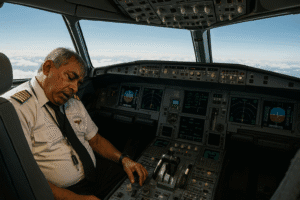Air India Pilot Collapse: 5 Shocking Reasons Why This Scary Cockpit Incident Matters Now
An Air India pilot collapsed in the cockpit just before operating Flight AI2414 from Bengaluru to Delhi on July 4, leading to a medical emergency. The pilot, who was preparing mandatory pre-flight documents, was immediately hospitalized and is now in stable condition. Air India swiftly arranged an alternate pilot, delaying the flight but ensuring passenger safety. The incident highlights concerns over pilot health, fatigue, and aviation safety protocols. Airlines face increasing pressure to enforce stricter medical checks and better workload management for flight crews.
While no passengers were endangered, the event underscores the need for robust emergency preparedness in aviation. Air India has assured full support for the pilot’s recovery while maintaining operational safety standards. This case adds to ongoing debates about balancing pilot well-being with the demands of modern air travel. Ultimately, it reinforces the critical role of health and contingency planning in aviation safety.

Air India Pilot Collapse: 5 Shocking Reasons Why This Scary Cockpit Incident Matters Now
In a concerning incident, an Air India pilot scheduled to operate Flight AI2414 from Bengaluru to Delhi collapsed in the cockpit just before departure on July 4. The airline confirmed the “medical emergency,” stating the pilot was hospitalized and is now stable. The flight, delayed due to the incident, was later operated by another pilot.
What Exactly Happened?
According to sources, the pilot was in the cockpit preparing to sign the mandatory technical log—a crucial pre-flight procedure—when he suddenly collapsed. Air India responded swiftly, ensuring the pilot received immediate medical attention. The airline has assured full support for the pilot’s recovery and family.
Why This Incident Raises Concerns
- Pilot Health & Fatigue Issues – Aviation professionals often work long hours under high stress. This incident highlights the need for stricter health monitoring and fatigue management in the industry.
- Flight Safety Protocols – While the situation was handled without endangering passengers, it underscores the importance of having backup pilots and emergency response plans.
- Passenger Impact – The delay caused inconvenience, but the airline prioritized safety by arranging an alternate pilot rather than rushing operations.
Air India’s Response
In its official statement, Air India emphasized that the pilot’s well-being was its top priority. The airline also assured passengers that all safety protocols were followed, and the flight was only resumed after ensuring full operational readiness.
Broader Implications for Aviation
This incident adds to ongoing discussions about:
- Mental and Physical Health Checks – Should airlines implement more frequent medical evaluations for pilots?
- Emergency Preparedness – How can airlines better handle in-cockpit medical emergencies mid-flight?
- Workload Management – Are current rest periods for pilots sufficient, especially during peak travel seasons?
Final Thoughts
While the pilot’s condition is now stable, this event serves as a reminder of the human factors in aviation safety. Both airlines and regulators must continuously evaluate health and operational policies to prevent such incidents in the future.
For now, Air India passengers can rest assured that the flight was handled with caution—proving that safety remains the top priority, even in unexpected crises.
You must be logged in to post a comment.